TMC2208 vs. TMC2209: How to Choose the Right Stepper Motor Drivers
The TMC22XX represents a class of motor driver ICs specifically designed for ultra-silent operation with two-phase stepper motors. Their pin configuration aligns seamlessly with several older driver models. TRINAMIC integrates the advanced StealthChop2 chopper, ensuring noise-free performance, optimal efficiency, and superior motor torque. The rapid regulation of current, coupled with the optional integration of SpreadCycle, enables exceptionally dynamic motion. The built-in power MOSFETs can manage motor currents of up to 1.4 ARMS. Protective and diagnostic features support robust and reliable operation. An easily accessible UART interface expands tuning and control possibilities, while application-specific adjustments can be stored in OTP memory. Representing the forefront of STEP/DIR stepper motor drivers, this family elevates design to a noiseless and precision-oriented level, offering cost-effective and highly competitive solutions.
Trinamic Motion Control manufactures the TMC2208 and TMC2209 stepper motor drivers, catering to the need for effective and noiseless motion control in various applications, including 3D printers. Numerous enthusiasts in the 3D printing community are exploring options to enhance their printers.
Both drivers have features like microstep interpolation, stealthChop for quiet operation, and stallGuard for sensorless homing. Despite their shared attributes, notable distinctions exist between these drivers. If you're considering the purchase of either of these motor drivers, we have a comprehensive guide tailored for you. In this article, we will dive into the differences between the TMC2208 and TMC2209 to help you choose the right stepper motor driver for your project.
Overview of TMC2208
The TMC2208 stands out as a quiet and highly efficient stepper motor driver specially crafted for integration into 3D printers. Serving as a direct substitute for the well-received TMC2100, it enhances performance and ensures a more hushed operation.
This driver boasts various features, encompassing stall detection, customizable current settings, and sensorless homing. It supports standard step and direction inputs and the versatility of SPI and UART control.
With a motor current delivery capability of up to 2.8A, the TMC2208 facilitates high-performance and noiseless functionality. This characteristic makes it a preferred option for individuals seeking to enhance their 3D printers. Additionally, its adeptness in detecting and preventing motor stalls contributes to mitigating potential damage to both the motor and the printer.
Moreover, the TMC2208 aligns seamlessly with popular 3D printer controllers like Marlin and Repetier.

Overview of TMC2209
The TMC2209 is a stepper motor driver specifically crafted for applications like 3D printers, CNC machines, and various robotics scenarios. Its design prioritizes high performance while maintaining low noise and minimal vibration. It incorporates micro-step interpolation, offering up to 256 micro-steps per step.
Employing a blend of digital and analog components, the TMC2209 ensures a seamless and quiet operational experience. Users benefit from diverse adjustable parameters and configurations, enabling customization according to their precise requirements.
Furthermore, the driver includes protective measures such as over-temperature, over-current, and under-voltage safeguards. It also boasts the stealthChop2 mode, enhancing the stepper motor's operation with a remarkable level of silence.

TMC2208 vs. TMC2209: Pinout
TMC2208 Pinout

TMC2209 Pinout
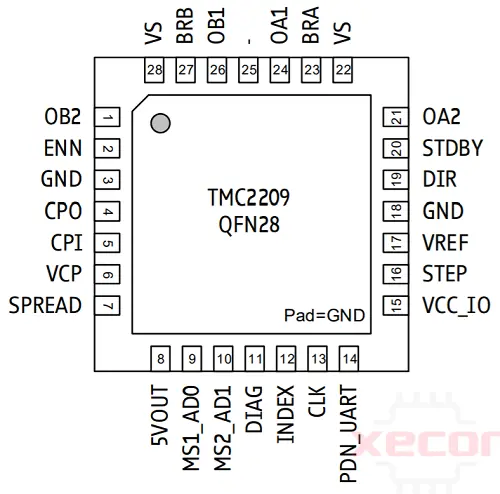
TMC2208 vs. TMC2209: Block Diagram
TMC2208 Block Diagram

TMC2209 Block Diagram

The TMC22xx family excels in power density, integrated power MOSFETs, smooth and noise-free operation, and intuitive simplicity. It spans various applications, from battery systems to embedded scenarios, accommodating motor currents of up to 2 A per coil. TRINAMIC introduces unique chopper modes, namely SpreadCycle and StealthChop2, which optimize drive performance. StealthChop significantly diminishes motor noise, rendering it virtually silent at low speeds. The reduction in standby current proves cost-effective for power dissipation and cooling. Comprehensive support facilitates swift design cycles, ensuring a rapid time-to-market with competitive products.
TMC2208 vs. TMC2209 Application Circuit
TMC2208 Application Circuit

TMC2209 Application Circuit

The TMC22xx family, designed as a seamless upgrade for existing economical stepper driver applications, incorporates StealthChop silent drive technology. This feature ensures smooth motion control without disturbances, making it ideal for home and office applications. Despite its compact size, the highly efficient power stage enables high current delivery.
The TMC2208, with its petite package, necessitates only a few control pins. These pins facilitate the selection of crucial settings, primarily the desired microstep resolution. Users can choose from 2, 4, 8, 16, or 32 microsteps, aligning the driver with the motion controller's capabilities. Some package options even allow chopper mode selection via pin.
Similarly, the TMC2209, in its compact package, requires just a few control pins. It permits users to select the essential setting: the desired microstep resolution. The options range from 8, 16, 32, or 64 microsteps or full step up to 1/256 step, ensuring the driver seamlessly adapts to the motion controller's capabilities.
TMC2208 vs. TMC2209: Feature & Benefit
TMC2208 Feature & Benefit
- Accommodates 2-phase stepper motors with a peak coil current of up to 2A
- Utilizes STEP/DIR Interface with pin settings for 2, 4, 8, 16, or 32 micro steps
- Achieves smooth operation with 256 micro steps through MicroPlyerTM interpolation
- Enables silent motor operation with StealthChop2TM
- Implements SpreadCycleTM for highly dynamic motor control chopper
- Low RDSon values of LS 280mΩ & HS 290mΩ (typical at 25°C)
- Operates within a voltage range of 4 to 36V DC
- Offers automatic standby current reduction as an option
- Provides an Internal Sense Resistor option, eliminating the need for external sense resistors
- Supports Passive Braking and Freewheeling
- Features Single Wire UART & OTP for advanced configuration possibilities
- Includes an Integrated Pulse Generator for standalone motion control
- Ensures Full Protection & Diagnostics
- Offers a choice between QFN and wettable QFN packages for optimal fitting.
TMC2209 Feature & Benefit
- Compatible with 2-phase stepper motors with a peak coil current of up to 2.8A and 2A RMS
- Utilizes STEP/DIR Interface with pin settings for 8, 16, 32, or 64 micro steps
- Achieves smooth operation with 256 micro steps through MicroPlyerM interpolation
- Enables silent motor operation with StealthChop2TM
- Implements SpreadCycleTM for highly dynamic motor control chopper
- Incorporates StallGuard4TH for load and stall detection in StealthChop mode
- Integrates CoolStepM's current control for energy savings of up to 75%
- Low RDSon values, with Low Heat-Up LS 170mΩ & HS 170mΩ (typical at 25°C)
- Operates within a voltage range of 4.7 to 29V DC
- Features Low Power standby to comply with standby energy regulations
- Provides an Internal Sense Resistor option, eliminating the need for external sense resistors
- Supports Passive Braking, Freewheeling, and automatic power-down
- Features Single Wire UART & OTP for advanced configuration possibilities
- Includes an Integrated Pulse Generator for standalone motion control
- Ensures Full Protection & Diagnostics
- Comes in a compact QFN package with a large heat slug.
TMC2208 vs. TMC2209 Alternative
There are the same alternatives for TMC2208 and TMC2209:
A4988: A comprehensive micro-stepping motor driver featuring a built-in translator for simplified operation. Its design caters to the seamless operation of bipolar stepper motors, supporting full-, half-, quarter-, eighth-, and sixteenth-step modes. An output drive capacity of up to 35 V and ±2 A ensures efficient motor control.
DRV8825: The DRV8825 comprises a stepper motor control board featuring the DRV8825 chip. This chip facilitates the management of stepper motors using firmware and software compatible with Arduino programming. The DRV8825 board can deliver a peak output current of up to 2.5 A or 1.75 A RMS (with adequate heatsinking) at 24 V and 25°C.
Refer to this article for more information about DRV8825 vs. A4988.
TMC2208 vs. TMC2209 Datasheet
TMC2208 Datasheet
TMC2209 Datasheet
TMC2208 vs. TMC2209: What's the Difference?
Current rating
The TMC2209 boasts a rating of up to 2.8A RMS current, surpassing the TMC2208 with its 1.2A RMS current rating. This indicates that the TMC2209 can manage higher current loads than the TMC2208. The difference in current rating indeed influences the performance of the stepper motors, allowing them to handle more substantial loads when paired with the TMC2209 as opposed to the TMC2208. Consequently, the TMC2209 is preferable for applications demanding increased power, including 3D printing, CNC machines, and robotics.
Step intervals
The TMC2209 encompasses a broader step interval range than the TMC2208, implying its capability to accommodate a more extensive array of micro-stepping resolutions. This characteristic renders the TMC2209 better suited for applications demanding meticulous control, such as 3D printers and laser cutters.
Voltage rating
The TMC2209 is designated for a maximum voltage of up to 45V, surpassing the TMC2208, rated for up to 36V. Consequently, the TMC2209 can manage higher voltage loads compared to the TMC2208.
Software compatibility
The TMC2209 exhibits compatibility with Trinamic's StealthChop2™ motion control software, a feature absent in the TMC2208. This compatibility implies that the TMC2209 can seamlessly integrate with Trinamic's motion control software, enabling smoother motion and enhanced control capabilities.
QNF package
Although both are packaged in a QFN format, there exists a subtle difference in their packaging configuration. The noteworthy distinction is that the TMC2209 has a large heat sink, whereas the TMC2208 features a wettable QFN package.
Braking system
Another distinction lies in the braking mechanisms employed by the two. The TMC2209 utilizes a passive braking system, reducing current when the stepper motor is stationary. On the other hand, the TMC2208 employs an active braking system that relies on an external resistor to dissipate stored energy in the motor during inactivity. The passive braking system employed by the TMC2209 proves to be more efficient than the active braking system used by the TMC2208.
Dimensions
Certainly, the dimensions do matter, as they impact the size of the board or the space within which the stepper motor drivers can be deployed.
TMC2208 vs. TMC2209: What are the Similarities?
Despite their differences, the two share similarities across various dimensions.
- Both function as Trinamic stepper motor drivers utilized in 3D printing applications.
- They both offer extensive control over current and micro-stepping levels.
- Both motors incorporate stall detection, stealthChop2, and stallGuard2 to ensure noiseless operation.
- Each can deliver up to 256 microsteps, contributing to seamless movement.
- Compatibility extends to most 3D printer boards, encompassing Marlin, Repetier, and Smoothieware.
- A built-in voltage regulator safeguards against power supply issues in both cases.
- Over-temperature and over-current protection are featured in both instances.
- A shared built-in PWM current control mechanism facilitates precise current control.
TMC2208 vs. TMC2209 Comparison Table
| TMC2208 | TMC2209 | |
| Interface | Step/Dir | Step/Dir |
| Configuration | CFG Pins or UART | CFG Pins or UART |
| Native Microsteps | up to 1/256 | up to 1/256 |
| microPlyer Microsteps | 1/256 | 1/256 |
| Logic Supply Voltage (VIO) | 3 - 5V | 3 - 5V |
| Motor Supply Voltage (VM) | 5.5 - 35V | 5.5 - 28V |
| Phase Current max (RMS) | 1.2A | 1.7A |
| RDSon | 0.3 Ohm | 0.2 Ohm |
| Rsense | 110 mOhm | 110 mOhm |
| Internal V-Regulator | enabled | enabled |
| Standby current reduction | yes | yes |
| stealthChop | yes | yes |
| spreadCycle | yes | yes |
| coolStep | - | yes |
| stallGuard | - | yes |
| dcStep | - | - |
TMC2208 vs. TMC2209: Which One Should I Choose?
The TMC2208 and TMC2209 serve as stepper motor drivers, with their primary distinction lying in the type of current control they employ.
The TMC2208 utilizes spreadCycle current control, ensuring a smoother and quieter operation. In contrast, the TMC2209 adopts stealthChop current control, offering increased torque and faster acceleration.
If your priority is a noiseless operation, the TMC2208 is the optimal choice. However, if your requirements include higher torque and swifter acceleration, the TMC2209 is preferable.
Considering cost is also prudent. Generally, the TMC2208 is more cost-effective than the TMC2209, making it a favorable choice for those working within budget constraints.
Conclusion
The TMC2208 and TMC2209 endorse 1/256 stepping, encompassing both interpolated and native modes. Both implement StealthChop V2, ensuring nearly silent printing. The selection of TMC2208 over TMC2209 in our board design was influenced by considerations tied to the specific machines and the design cycle. Since both employ similar technologies for motor regulation and maintain identical noise levels, there are no distinctions in print quality between 2208 and 2209.
Read More
Previous:
FAQ
-
What does the TMC2208 and TMC 2209 support?
1/256 stepping.
-
What do the TMC2208 and TMC 2209 use for whisper-quiet printing?
StealthChop V2.
-
Is TMC2208 compatible with A4988?
No, TMC2208 stepper motor drivers are incompatible with A4988 stepper motor drivers. Despite their shared purpose as stepper motor drivers, the TMC2208 employs a distinct protocol, rendering it incompatible with the A4988 on a direct level.
-
How do I enable TMC2208?
To activate a TMC2208 stepper motor driver, link the driver to the correct power and motor interfaces. Subsequently, employ an appropriate instrument to transmit the requisite directives to the driver for activation. Connect the driver and a microcontroller or a compatible device, like an Arduino, for this task. Once linked, dispatch the pertinent commands from the microcontroller to the driver to initiate activation. For a more comprehensive guide on enabling a TMC2208 driver, consult the product manual associated with the driver.
-
What is the difference between TMC2208 and TMC2208_STANDALONE?
Selecting TMC2208 implies a preference for controlling SilentStepStick via UART. On the other hand, TMC2208_STANDALONE indicates the absence of UART control, relying on STEP/DIR inputs instead.
-
Are Both TMC2208 and TMC2209 Interchangeable with A4988?
You can upgrade your current A4988 with a TMC2208 or a TMC2209, delivering improved performance.
-
Are Both TMC2208 and TMC2209 Interchangeable with DRV8825?
Trinamic's TMC2209 and TMC2208 are compatible with the DRV8825 in pin configuration. You can seamlessly substitute a DRV8825 with a TMC2209 or TMC2208 without encountering any issues. It is advisable to review the datasheets for both the TMC2209/TMC2208 and the DRV8825 before proceeding with the replacement process.
-
Are stepper motors stronger than servos?
Servo motors exhibit higher efficiency levels than stepper motors, achieving 80-90% efficiency.

 Prof. David Reynolds
Prof. David Reynolds




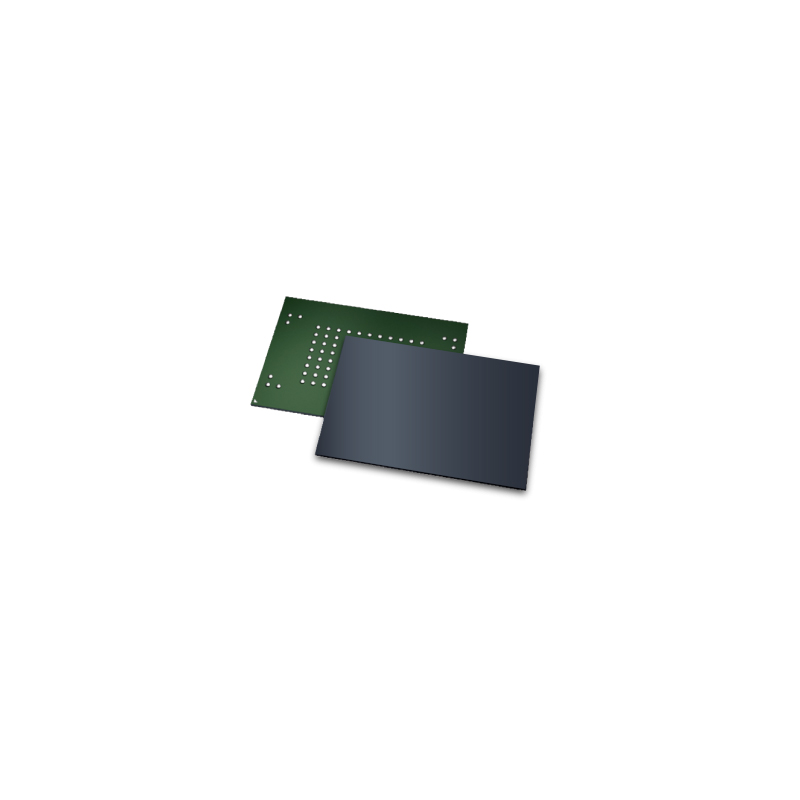
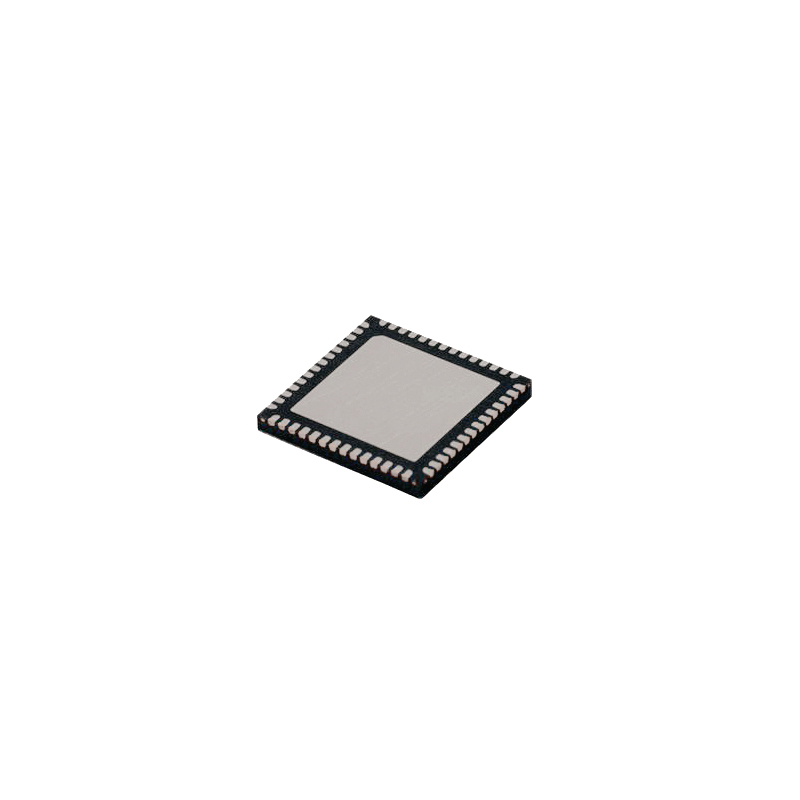

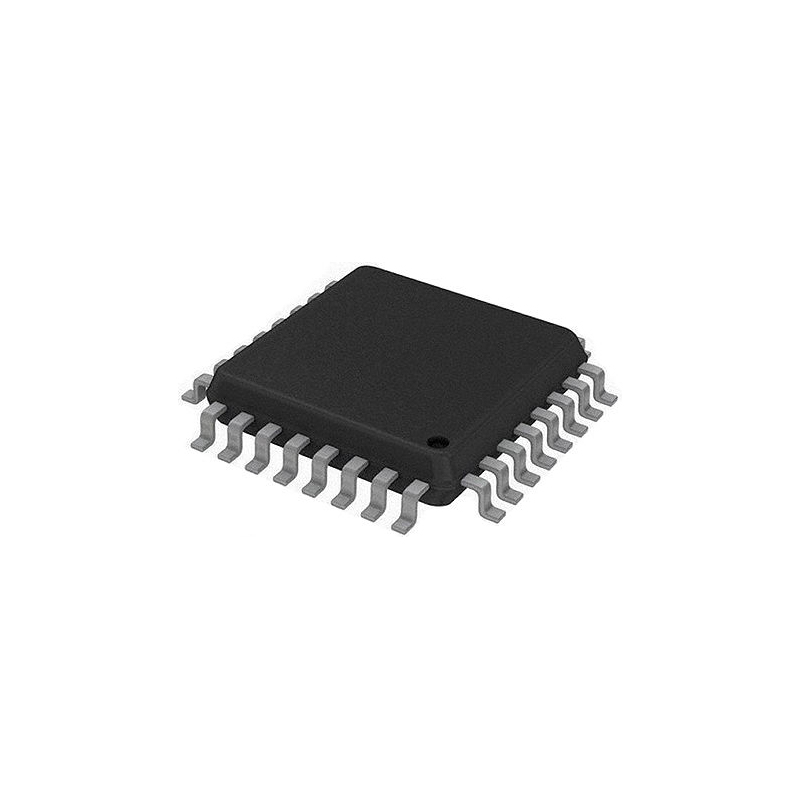


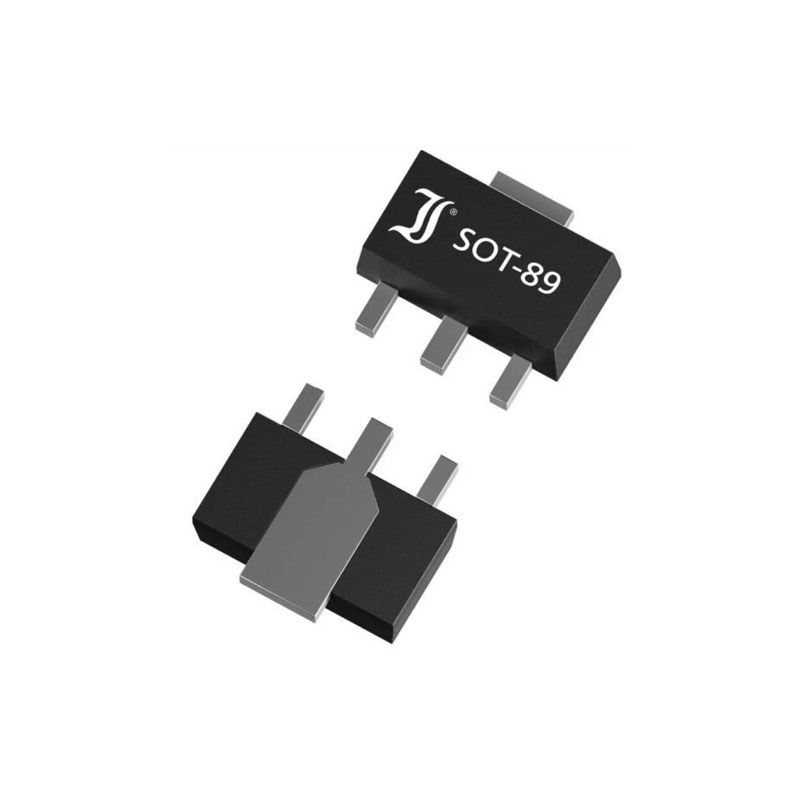
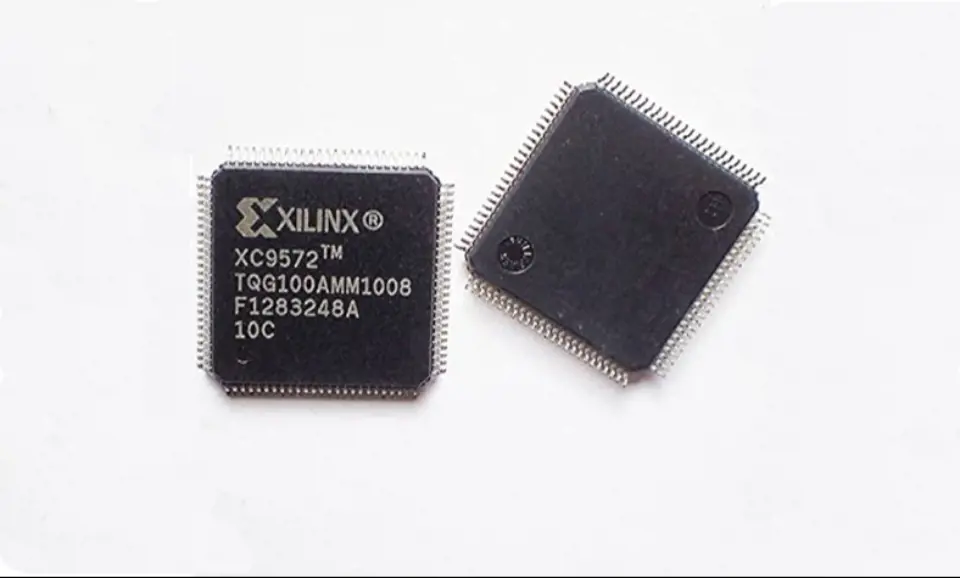
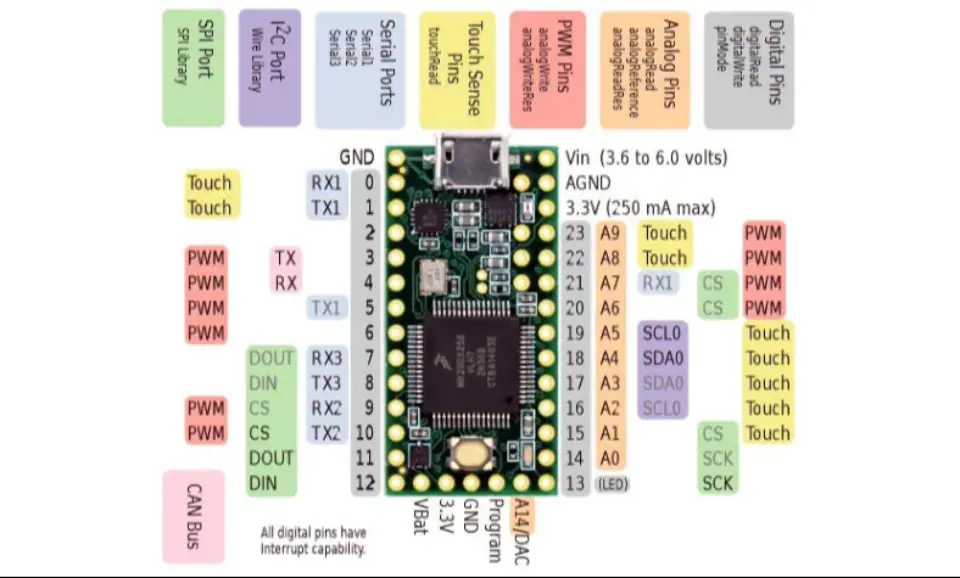
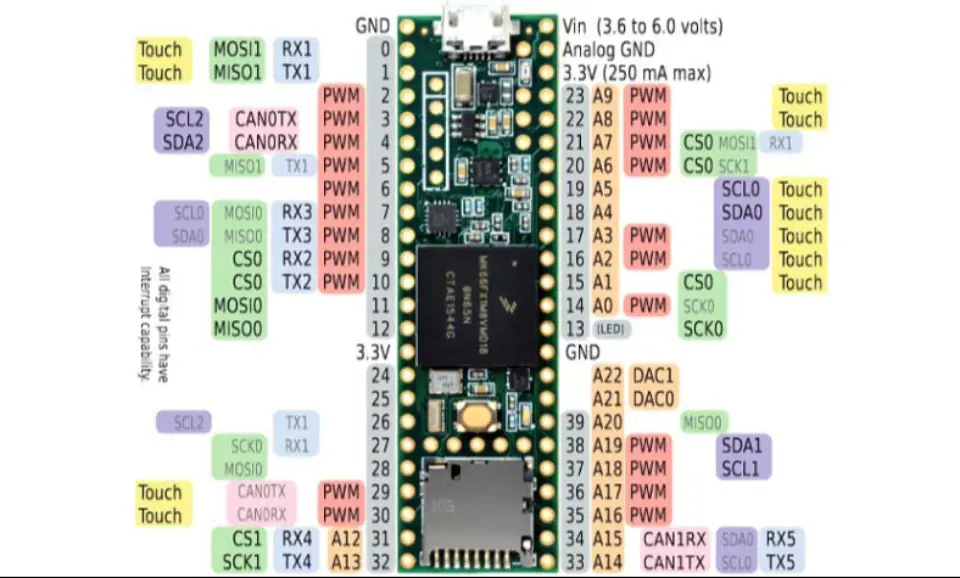
Still, need help? Contact Us: [email protected]